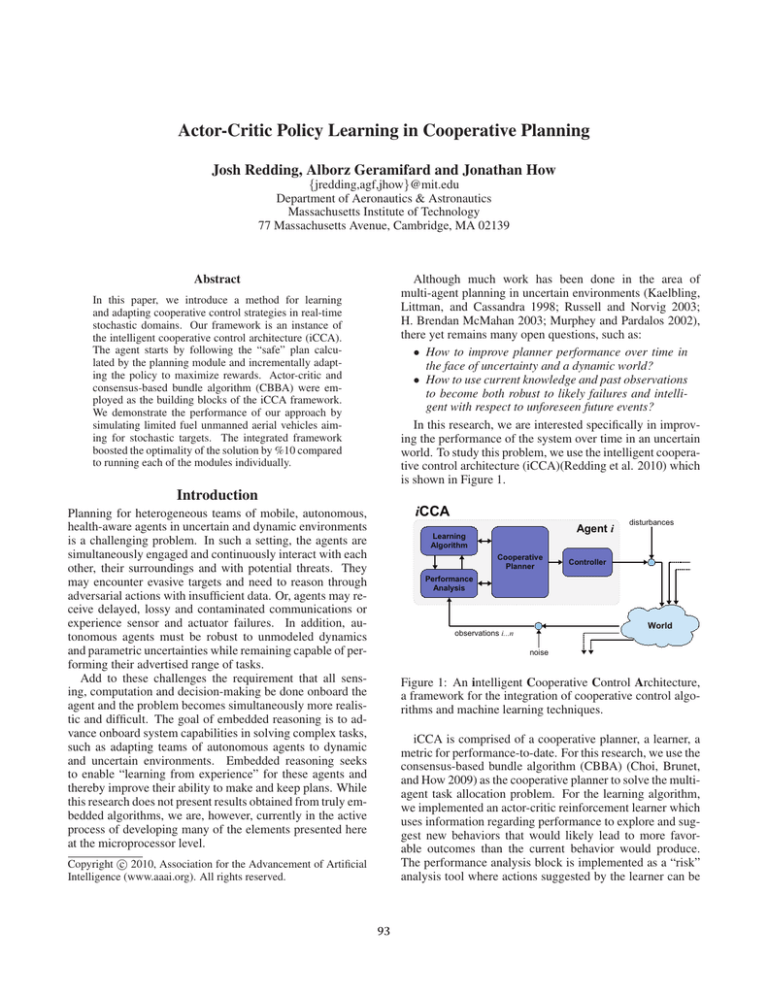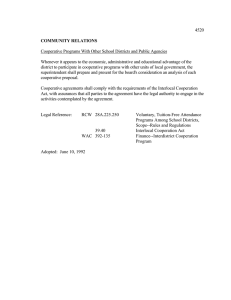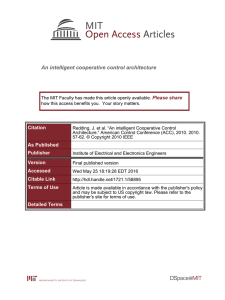
Actor-Critic Policy Learning in Cooperative Planning
Josh Redding, Alborz Geramifard and Jonathan How
{jredding,agf,jhow}@mit.edu
Department of Aeronautics & Astronautics
Massachusetts Institute of Technology
77 Massachusetts Avenue, Cambridge, MA 02139
Although much work has been done in the area of
multi-agent planning in uncertain environments (Kaelbling,
Littman, and Cassandra 1998; Russell and Norvig 2003;
H. Brendan McMahan 2003; Murphey and Pardalos 2002),
there yet remains many open questions, such as:
• How to improve planner performance over time in
the face of uncertainty and a dynamic world?
• How to use current knowledge and past observations
to become both robust to likely failures and intelligent with respect to unforeseen future events?
In this research, we are interested specifically in improving the performance of the system over time in an uncertain
world. To study this problem, we use the intelligent cooperative control architecture (iCCA)(Redding et al. 2010) which
is shown in Figure 1.
Abstract
In this paper, we introduce a method for learning
and adapting cooperative control strategies in real-time
stochastic domains. Our framework is an instance of
the intelligent cooperative control architecture (iCCA).
The agent starts by following the “safe” plan calculated by the planning module and incrementally adapting the policy to maximize rewards. Actor-critic and
consensus-based bundle algorithm (CBBA) were employed as the building blocks of the iCCA framework.
We demonstrate the performance of our approach by
simulating limited fuel unmanned aerial vehicles aiming for stochastic targets. The integrated framework
boosted the optimality of the solution by %10 compared
to running each of the modules individually.
Introduction
Planning for heterogeneous teams of mobile, autonomous,
health-aware agents in uncertain and dynamic environments
is a challenging problem. In such a setting, the agents are
simultaneously engaged and continuously interact with each
other, their surroundings and with potential threats. They
may encounter evasive targets and need to reason through
adversarial actions with insufficient data. Or, agents may receive delayed, lossy and contaminated communications or
experience sensor and actuator failures. In addition, autonomous agents must be robust to unmodeled dynamics
and parametric uncertainties while remaining capable of performing their advertised range of tasks.
Add to these challenges the requirement that all sensing, computation and decision-making be done onboard the
agent and the problem becomes simultaneously more realistic and difficult. The goal of embedded reasoning is to advance onboard system capabilities in solving complex tasks,
such as adapting teams of autonomous agents to dynamic
and uncertain environments. Embedded reasoning seeks
to enable “learning from experience” for these agents and
thereby improve their ability to make and keep plans. While
this research does not present results obtained from truly embedded algorithms, we are, however, currently in the active
process of developing many of the elements presented here
at the microprocessor level.
Figure 1: An intelligent Cooperative Control Architecture,
a framework for the integration of cooperative control algorithms and machine learning techniques.
iCCA is comprised of a cooperative planner, a learner, a
metric for performance-to-date. For this research, we use the
consensus-based bundle algorithm (CBBA) (Choi, Brunet,
and How 2009) as the cooperative planner to solve the multiagent task allocation problem. For the learning algorithm,
we implemented an actor-critic reinforcement learner which
uses information regarding performance to explore and suggest new behaviors that would likely lead to more favorable outcomes than the current behavior would produce.
The performance analysis block is implemented as a “risk”
analysis tool where actions suggested by the learner can be
c 2010, Association for the Advancement of Artificial
Copyright Intelligence (www.aaai.org). All rights reserved.
93
+100
[2,3]
overridden by the baseline cooperative planner if they are
deemed too risky. This synergistic planner-learner relationship yields a “safe” policy in the eyes of the planner, upon
which the learner can only improve. Ultimately, this relationship will help to bridge the gap to successful and intelligent execution in real-world missions.
The remainder of this paper details the integration of
learning with cooperative control and shows how the marriage of these two fields results in an intelligent, adaptable
planning scheme in the context of teams of autonomous
agents in uncertain environments. In the following section,
we motivate and formally states the multi-agent planning
problem. The specifics of the proposed architecture are then
detailed and followed by a discussion of simulation results
and conclusions.
2
1
.5
3
+100
5
6
.7
8
[2,3]
+100
4
.5
5
+300
7
Problem Statement
[3,4]
+200
.6
Figure 2: The mission scenario of interest: A team of two
UAVs plan to maximize their total reward by cooperating to
visit targets. Target nodes are shown as circles with rewards
noted as positive values and the probability of receiving the
reward shown in the associated cloud. Note that some target
nodes have no value. Constraints on the allowable visit time
of a target are shown in brackets.
Having introduced the general problem, a few key research
gaps and outlined the proposed solution, we now prepare to
delve deeper into our approach by formally presenting the
problem we aim to solve and by giving background information. We first outline a small yet difficult multi-agent scenario where traditional cooperative control tends to struggle.
We then formulate the planning problem associated with this
complex scenario and further discuss existing solutions. The
following section then discusses the technical details of the
proposed solution approach and explains how it fills the research gap of interest.
relevant background. The MDP framework provides a general formulation for sequential planning under uncertainty.
a
a
An MDP is defined by tuple (S, A, Pss
, Rss , γ), where S
is the set of states, A is the set of possible actions. Taka
ing action a from state s has Pss
probability of ending up
in state s and receiving reward Rass . Finally γ ∈ [0, 1] is
the discount factor used to prioritize early rewards against
future rewards.2 A trajectory of experience is defined by
sequence s0 , a0 , r0 , s1 , a1 , r1 , · · · , where the agent starts at
state s0 , takes action a0 , receives reward r0 , transit to state
s1 , and so on. A policy π is defined as a function from S ×A
to the probability space [0, 1], where π(s, a) corresponds to
the probability of taking action a from state s. The value of
each state-action pair under policy π, Qπ (s, a), is defined
as the expected sum of discounted rewards when the agent
takes action a from state s and follow policy π thereafter:
∞
π
t−1 γ rt s0 = s, a0 = a, .
Q (s, a) = Eπ
Problem Scenario
Here we outline the scenario in which we developed and
tested each of the modules in the iCCA framework. Referring to Figure 2, we see a depiction of the mission scenario
of interest where a team of two fuel-limited UAVs cooperate to maximize their total reward by visiting valuable target
nodes in the network. The base is highlighted as node 1
(green circle), targets are shown as blue circles and agents
as triangles. The total amount of fuel for each agent is highlighted by the number inside each triangle. For those targets with an associated reward it is given a positive number
nearby. The constraints on when the target can be visited
are given in square brackets and the probability of receiving
the known reward when the target is visited is given in the
white cloud nearest the node.1 Each reward can be obtained
only once and all edges take one fuel cell and one time step.
We also allow UAVs to loiter on any nodes for the next time
step. The fuel burn for loitering action is also one except for
the UAVs sStaying in the base, where they assumed to be
stationary and sustain no fuel cost. The mission horizon was
set to 8 time steps.
t=1
The optimal policy π ∗ maximizes the above expectation
for all state-action pairs:
∗
π ∗ = argmaxa Qπ (s, a)
MDP Formulation
Markov Decision Processes
Here, we formulate the scenario of interest into an MDP, as
described above.
As the scenario above is modeled as a multi-agent Markov
Decision Process (MDP) (Howard 1960; Puterman 1994;
Littman, Dean, and Kaelbling 1995), we first provide some
State Space S : We formulated the state space as
[N1 , F1 , . . . , Nn , Fn , V1 , . . . , Vm , t]T , where Ni and Fi are
2
γ can be set to 1 only for episodic tasks, where the length of
trajectories are fixed.
1
If two agents visit a node at the same time, the probability of
visiting the node would increase accordingly.
94
integer values highlighting the location and the remaining
fuel for UAV i, Vj is a single bit signaling if node j has been
ever visited before, and t is the current time step. There are
n UAVs and m nodes participating in the scenario.
the application in a manner that optimizes an underlying,
user-defined objective function. Many existing cooperative
control algorithms use observed performance to calculate
temporal-difference errors which drive the objective function in the desired direction (Murphey and Pardalos 2002;
Bertsekas and Tsitsiklis 1996). Regardless of how it is formulated ( e.g. MILP, MDP, CBBA, etc...), the cooperative
planner, or cooperative control algorithm, is the source for
baseline plan generation within iCCA.
In this research, we implemented a decentralized auction protocol called the consensus-based bundle algorithm
(CBBA) as the cooperative planner. The following section
details this approach.
Action Space A : Action space is [N1+ , . . . , Nn+ ] where
Ni+ is the node to which UAV i is traveling or, where it will
be at the next time interval.
a
: Transition function is deterTransition Function Pss
ministic for the UAV position, fuel consumption, and time
variables of the state space, while it is stochastic for the visited list of targets. The detailed derivation of the complete
transition function should be trivial following Figure 2.
Consensus-Based Bundle Algorithm CBBA is a decentralized auction protocol that produces conflict-free assignments that are relatively robust to disparate situational
awareness over the network.
CBBA consists of iterations between two phases: In the
first phase, each vehicle generates a single ordered bundle of tasks by sequentially selecting the task giving the
largest marginal score. The second phase resolves inconsistent or conflicting assignments through local communication between neighboring agents. In the local communication round, some agent i sends out to its neighboring agents
two vectors of length Nt : the winning agents vector zi ∈ ItN
t
and the winning bids vector yi ∈ RN
+ . The j-th entries of
the zi and yi indicate who agent i thinks is the best agent to
take task j, and what is the score that agent gets from task
j, respectively. The essence of CBBA is to enforce every
agent to agree upon these two vectors, leading to agreement
on some conflict-free assignment regardless of inconsistencies in situational awareness over the team.
There are several core features of CBBA identified in
(Choi, Brunet, and How 2009). First, CBBA is a decentralized decision architecture. For a large team of autonomous agents, it would be too restrictive to assume the
presence of a central planner (or server) with which every
agent communicates. Instead, it is more natural for each
agent to share information via local communication with
its neighbors. Second, CBBA is a polynomial-time algorithm. The worst-case complexity of the bundle construction
is O(Nt Lt ) and CBBA converges within max{Nt , Lt Na }D
iterations, where Nt denotes the number of tasks, Lt the
maximum number of tasks an agent can win, Na the number of agents and D is the network diameter, which is always less than Na . Thus, the CBBA methodology scales
well with the size of the network and/or the number of tasks
(or equivalently, the length of the planning horizon). Third,
various design objectives, agent models, and constraints can
be incorporated by defining appropriate scoring functions.
If the resulting scoring scheme satisfies a certain property
called diminishing marginal gain (DMG), a provably good
feasible solution is guaranteed.
While the scoring function primarily used in (Choi,
Brunet, and How 2009) was a time-discounted reward, a
more recent version of the algorithm is due to Ponda (Ponda
et al. 2010) and handles the following extensions while pre-
Reward Function Rass : The reward on each time step is
stochastic and calculated as the sum of rewards from visiting new desired targets minus the total burnt fuel cells on the
last move (Figure 2). Notice that a UAV receives the target
reward only if it lands on an unvisited rewarding node and
lucky enough to obtain the reward. In that case, the corresponding visibility bit will turn on, and the agent receive the
reward. We set the crash penalty to −800, which occurs if
any UAVs runs out of fuel or is not at the base by the end of
the mission horizon.
iCCA
In this section, we detail our instance of the intelligent cooperative control architecture (iCCA), describing the purpose
and function of each element and how the framework as a
whole fits together with the MDP formulated in the previous
section.
iCCA Elements
Figure 3: iCCA framework as implemented. CBBA planner and risk analysis and the actor-critic learner formulated
within an MDP.
Cooperative Planner
At its fundamental level, the cooperative planner yields
a solution to the multi-agent path planning, task assignment or resource allocation problem, depending on the domain. This means it seeks to fulfill the specific goals of
95
serving convergence properties:
• Tasks that have finite time windows of validity
• Heterogeneity in the agent capabilities
• Vehicle fuel cost
This research uses this extended version of CBBA as the
cooperative planner.
overridden by the baseline CBBA if the action leads UAVs
into a configuration where crashing scenario is inevitable.
As the agents implement the policy, the critic receives rewards for the actor’s actions.
As a reinforcement learning algorithm, iCCA introduces
the key concept of bounded exploration such that the learner
can explore the parts of the world that may lead to better
system performance while ensuring that the agent remain
safely within its operational envelope and away from states
that are known to be undesirable, such as running out of
fuel. In order to facilitate this bound, the risk analysis module inspects all suggested actions of the actor, and replaces
the risky ones with the baseline CBBA policy. This process guides the learning away from catastrophic errors. In
essence, the baseline cooperative control solution provides a
form of “prior” over the learner’s policy space while acting
as a backup policy in the case of an emergency.
However, a canonical failure of learning algorithms in
general, is that negative information is extremely useful in
terms of the value of information it provides. We therefore introduce the notion of a “virtual reward”. In this research, the virtual reward is a large negative value delivered
by the risk analysis module to the learner for risky actions
suggested by the latter and pruned by the former. When this
virtual reward is delivered, the learner associates it with the
previously suggested action, therefore dissuading the learner
from suggesting that action again, reducing the number of
“emergency calls” in the future.
Risk/Performance Analysis
One of the main reasons for cooperation in a cooperative
control mission is to minimize some cost, or objective function. Very often this objective involves time, risk, fuel, or
other similar physically-meaningful quantities. The purpose
of the performance analysis module is to accumulate observations, glean useful information buried in the noise, categorize it and use it to improve subsequent plans. In other
words, the performance analysis element of iCCA attempts
to improve agent behavior by diligently studying its own experiences (Russell and Norvig 2003) and compiling relevant
signals to drive the learner and/or the planner.
The use of such feedback within a planner is of course
not new. In fact, there are very few cooperative planners
which do not employ some form of measured feedback. In
this research, we implemented this module as a risk analysis
element where candidate actions are evaluated for risk level.
Actions deemed too risky are replaced with another of lower
risk. The details of this feature are given later on.
Learning Algorithm
Although learning has many forms, iCCA provides a minimally restrictive framework where the contributions of the
learner to fall into either of two categories:
1. Assist the cooperative planner by adapting to parametric uncertainty of internal models
2. Suggesting candidate actions to the cooperative planner that the learner sees as beneficial
As our focus for this research is on the latter category, we
chose to formulate the learner as an actor-critic type and set
it under a Markov Decision Process framework, as described
previously. In actor-critic learning, the actor handles the policy, where in our experiments actions are selected based on
Gibbs softmax method:
Flight Results
In this section, we present and discuss simulation results for
the given scenario and problem formulation. First we solved
the problem using backward dynamic programing in order to
use this solution as the baseline for the optimality.3 We ran
the CBBA on the converted stochastic problem into the expected deterministic problem, and ran it for 10,000 episodes.
Finally we empirically searched for the best learning rates
for the Actor-Critic and iCCA where the earning rate calculated by:
N0 + 1
αt = α0
.
N0 + Episode#1.1
The best α0 and N0 have been selected through experimental search of the sets of α0 ∈ {0.01, 0.1, 1} and N0 ∈
{100, 100, 106 } for each method. For all experiments, we
set the preference of the advised CBBA state-action pairs to
100. τ was set to 1 for the actor. Figure 4 depicts the performance of iCCA and Actor-Critic averaged over 60 runs. The
Y-axis shows the cumulative reward, while the X-axis represents the number of interactions. Each point on the graph is
the result of running the greedy policy with respect to the existing preferences of the actor. For iCCA, risky moves again
were replaced by the CBBA baseline solution. Error bars
represent the standard error with %90 confidence interval.
In order to show the relative performance of these methods
with offline techniques, the optimal and CBBA solutions are
eP (s,a)/τ
π(s, a) = P (s,b)/τ ,
be
in which P (s, a) is the preference of taking action a in state
s, and τ ∈ (0, ∞] is the temperature parameter acting as nob
shifting from greedy towards random action selection. Since
we use a tabular representation the actor update amounts to:
P (s, a) ← P (s, a) + αQ(s, a)
following the incremental natural actor-critic framework
(Bhatnagar et al. 2007). As for the critic, we employed the
Sarsa algorithm [See (Sutton and Barto 1998)] to update the
associated value function estimate. We initialized the actor’s
policy by boosting the initial preference of the actions generated by CBBA. As actions are pulled from the policy for
implementation, they are evaluated for risk level and can be
3
This computation took about a day and can not be easily scaled
for larger sizes of the problem.
96
Conclusions
highlighted as lines. It is clear that the actor-critic performs
much better when wrapped into the iCCA framework and
performs better than CBBA alone. The reason is that CBBA
provides a good starting point for the actor-critic to explore
the state space, while the risk analyzer filters risky actions
of the actor which leads into catastrophic scenarios. Figure 5 shows the optimality of iCCA and Actor-Critic after
105 steps of interaction with the domain and the averaged
optimality of CBBA through 10, 000 trials. Notice how the
integrated algorithm could on average boost the best individual optimality performance of both individual components
by %10.
In conclusion, we introduced a method for learning and
adapting cooperative control strategies in real-time stochastic domains. Our framework of choice was an instance of
the intelligent cooperative control architecture (iCCA) presented in (Redding et al. 2010). A “safe” plan was generated
by the Consensus-Based Bundle Algorithm (Choi, Brunet,
and How 2009), which initialized a policy which was then
incrementally adapted by a natural actor-critic learning algorithm to increase planner performance over time. We successfully demonstrated the performance of our approach by
simulating limited-fuel UAVs aiming for stochastic targets
in an uncertain world.
Optimal
Acknowledgments
This research was generously supported by Boeing Research
& Technology, Seattle, WA and by AFOSR grant FA955008-1-0086.
CBBA
iCCA
Actor-Critic
References
Bertsekas, D., and Tsitsiklis, J. 1996. Neuro-Dynamic Programming. Belmont, MA: Athena Scientific.
Bhatnagar, S.; Sutton, R. S.; Ghavamzadeh, M.; and Lee, M.
2007. Incremental natural actor-critic algorithms. In Platt, J. C.;
Koller, D.; Singer, Y.; and Roweis, S. T., eds., NIPS, 105–112.
MIT Press.
Choi, H.-L.; Brunet, L.; and How, J. P. 2009. Consensus-based
decentralized auctions for robust task allocation. IEEE Trans. on
Robotics 25 (4):912 – 926.
H. Brendan McMahan, Geoffrey J. Gordon, A. B. 2003. Planning in the presence of cost functions controlled by an adversary.
In Proceedings of the Twentieth International Conference on Machine Learning.
Howard, R. A. 1960. Dynamic programming and markov processes.
Kaelbling, L. P.; Littman, M. L.; and Cassandra, A. R. 1998.
Planning and acting in partially observable stochastic domains.
Artificial Intelligence 101:99–134.
Littman, M. L.; Dean, T. L.; and Kaelbling, L. P. 1995. On the
complexity of solving markov decision problems. In In Proc. of
the Eleventh International Conference on Uncertainty in Artificial
Intelligence, 394–402.
Murphey, R., and Pardalos, P. 2002. Cooperative control and
optimization. Kluwer Academic Pub.
Ponda, S.; Redding, J.; Choi, H.-L.; Bethke, B.; How, J. P.; Vavrina, M.; and Vian, J. L. 2010. Decentralized planning for complex missions with dynamic communication constraints. In submitted to American Control Conference.
Puterman, M. L. 1994. Markov decision processes.
Redding, J.; Undurti, A.; Choi, H.; and How, J. 2010. An Intelligent Cooperative Control Architecture. In American Control
Conference, to appear.
Russell, S., and Norvig, P. 2003. Artificial Intelligence, A Modern
Approach.
Sutton, R. S., and Barto, A. G. 1998. Reinforcement Learning:
An Introduction. MIT Press.
Figure 4: A comparison of the collective rewards received
when strictly following plans generated by CBBA alone,
actor-critic reinforcement learning outside of the iCCA environment, i.e. without initialization and guidance from
CBBA, and the result when these are coupled via the iCCA
framework are all compared against the optimal performance as calculated via dynamic programming
Optimality
100
90
80
70
60
50
40
30
iCCA
CBBA
Actor-Critic
Figure 5: A comparison of optimality for CBBA alone,
actor-critic reinforcement learning outside of the iCCA environment, i.e. without initialization and guidance from
CBBA, and the result when these are coupled via the iCCA
framework. The optimal result was found via dynamic programming.
97







